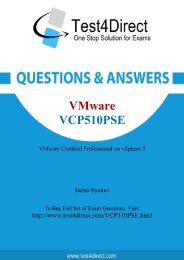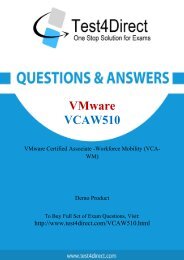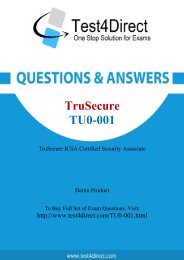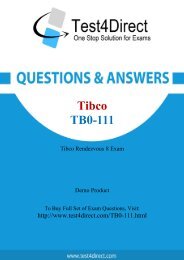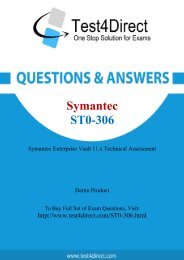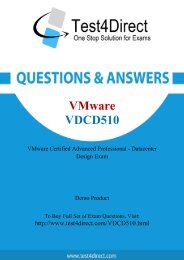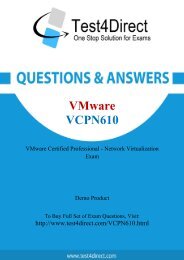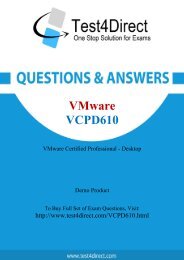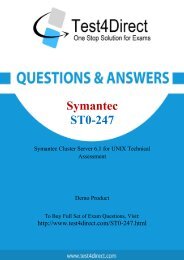Here you get free SPHR Exam BrainDumps
Test4Direct provides latest PDF questions of HRCI SPHR exam. You have an opportunity to pass the HRCI SPHR exam in one go. Test4Direct is most accurate source to prepare HRCI SPHR exam as your success will become site’s responsibility after purchasing SPHR exam product. There are also lots of discounts and promotion offers that you can avail. Let’s try a free demo http://www.test4direct.com/SPHR.html
Test4Direct provides latest PDF questions of HRCI SPHR exam. You have an opportunity to pass the HRCI SPHR exam in one go. Test4Direct is most accurate source to prepare HRCI SPHR exam as your success will become site’s responsibility after purchasing SPHR exam product. There are also lots of discounts and promotion offers that you can avail. Let’s try a free demo http://www.test4direct.com/SPHR.html
Create successful ePaper yourself
Turn your PDF publications into a flip-book with our unique Google optimized e-Paper software.
HRCI<br />
<strong>SPHR</strong><br />
<strong>SPHR</strong> - Senior Professional in Human Resources<br />
Demo Product<br />
To Buy Full Set of <strong>Exam</strong> Questions, Visit:<br />
http://www.test4direct.com/<strong>SPHR</strong>.html
Question: 1<br />
Which of the following functional areas covers activities related to planning for and managing entry<br />
into and exit from the organization to meet changing business needs?<br />
A. Workforce Planning and Employment<br />
B. Business Management and Strategy<br />
C. Human Resource Development<br />
D. Employee and Labor Relations<br />
Question: 2<br />
Answer: A<br />
Explanation:<br />
Answer option A is correct.<br />
Workforce Planning and Employment covers activities related to planning for and managing entry<br />
into and exit from the organization to meet changing business needs. This includes practices for<br />
evaluating workforce requirements, recruitment and selection, developing an employer brand,<br />
managing records, establishing a succession plan, and exiting employees from the organization.<br />
Answer option B is incorrect. Business Management and Strategy looks at the "big picture" of the<br />
organization and requires an understanding of overall business operations, basic knowledge of other<br />
functional areas in the organization, and the ability to interact and work effectively with those<br />
functions.<br />
Answer option C is incorrect. Human Resource Development utilizes training, development, change,<br />
and performance management programs to ensure that individuals with the required knowledge,<br />
skills, and abilities are available when needed to accomplish organization goals.<br />
Answer option D is incorrect. Employee and Labor Relations address the practices for building<br />
positive employment relationships in both union and nonunion environments. This includes<br />
employee relations programs, workplace policies and procedures, dispute resolution programs, and<br />
collective bargaining activities.<br />
Chapter: Certifying Human Resource Professionals<br />
Objective: Development of the Human Resource Body of Knowledge<br />
According to Knowles, there are five key assumptions about how adults learn. One of the<br />
assumptions is the learner's need to know. Which of the following statements is best associated with<br />
the assumption of the learner's need to know?<br />
A. I'm ready to learn this because what I learn will help me function better in some way.<br />
B. I understand why I need to learn this.<br />
C. What I learn today will help me solve problems at my workplace tomorrow.<br />
D. I've got lots of valuable experience that I want to draw upon to help me as I learn.<br />
Explanation:<br />
Answer option B is correct.<br />
Answer: B
The statement "I understand why I need to learn this" is an assumption that the learner understands<br />
the need to know the course material.<br />
Answer option A is incorrect. The statement "I'm ready to learn this because what I learn will help<br />
me function better in some way" is an example of the assumption of the learner's readiness to learn.<br />
Answer option C is incorrect. The statement "What I learn today will help me solve problems at my<br />
workplace tomorrow" is an example of the assumption of the learner's orientation to learning.<br />
Answer option D is incorrect. The statement "I've got lots of valuable experience that I want to draw<br />
upon to help me as I learn" is an example of the assumption of the learner's experience.<br />
Reference: Professional in Human Resources Certification Guide, Sybex, ISBN: 978-0-470-43096-5.<br />
Chapter 5: Human Resource Development. Official PHR and <strong>SPHR</strong> Certification Guide, HR<br />
Certification Institute, ISBN: 978-1-586-44149-4, Section III, The US Body of Knowledge.<br />
Chapter: Core Knowledge Requirements for HR Professionals<br />
Objective: Adult Learning Processes and Learning Styles<br />
Question: 3<br />
As an HR Professional <strong>you</strong> must be familiar with the project management processes and the<br />
stakeholders of projects. All projects can map to the project management lifecycle. Which one of the<br />
following best describes the project management lifecycle?<br />
A. It is a unique life of each project -from its initiation through its closing.<br />
B. It is the aggregation of the nine knowledge areas of project management: integration<br />
management, scope, schedule, costs, quality, human resources, communication, risk, and<br />
procurement.<br />
C. It is the life of the management of the project -from initiation, planning, execution, controlling,<br />
through closing.<br />
D. It is the life of a project to interact with all areas including scope, schedule, costs, quality, human<br />
resources, communication, risk, and procurement.<br />
Question: 4<br />
Answer: C<br />
Explanation:<br />
Answer option C is correct.<br />
The project management lifecycle is the flow of project management activities through the five<br />
process groups of initiating, planning, executing, controlling, and closing.<br />
Answer option A is incorrect. This answer describes the project life cycle - which is unique to each<br />
project; not universal to all projects.<br />
Answer option B is incorrect. This answer describes the integrated nature of projects where<br />
performance in each knowledge area can affect the performance of all other knowledge areas.<br />
Answer option D is incorrect. This answer describes project integration management - the<br />
coordination of all necessary project management processes throughout the nine knowledge areas<br />
of project management.<br />
Reference: PHR <strong>Exam</strong> Prep, Pearson Education, ISBN: 978-0-7897-3677-2. Chapter Three: Strategic<br />
Management. Official PHR and <strong>SPHR</strong> Certification Guide, HR Certification Institute, ISBN: 978-1-586-<br />
44149-4, Section III, The US HR Body of Knowledge.<br />
Chapter: Core Knowledge Requirements for HR Professionals<br />
Objective: Project Management Concepts
The Department of Labor establishes the rules for unemployment insurance and associated claims.<br />
Who administers the unemployment?<br />
A. The Department of Labor<br />
B. Each state<br />
C. Insurance companies<br />
D. Each organization<br />
Question: 5<br />
Question: 6<br />
Answer: B<br />
Explanation:<br />
Answer option B is correct.<br />
Unemployment insurance claims are managed locally within each state, but federal rules do apply.<br />
Answer option A is incorrect. Unemployment claims are not managed by the department of labor.<br />
Answer option C is incorrect. Insurance companies do provide unemployment insurance, but it's the<br />
local state government that manages the claims.<br />
Answer option D is incorrect. Each organization does not manage the unemployment claims.<br />
Reference: PHR <strong>Exam</strong> Prep, Pearson Education, ISBN: 978-0-7897-3677-2. Chapter Six: Total Rewards.<br />
Official PHR and <strong>SPHR</strong> Certification Guide, HR Certification Institute, ISBN: 978-1-586-44149-4,<br />
Section III, The US HR Body of Knowledge.<br />
Chapter: Core Knowledge Requirements for HR Professionals<br />
Objective: Diversity Concepts<br />
A correlation coefficient is an example of a type of what?<br />
A. Qualitative analysis<br />
B. Quantitative analysis<br />
C. Job evaluation<br />
D. Learning matrix<br />
Answer: B<br />
Explanation:<br />
Answer option B is correct.<br />
Qualitative analysis is a form of research that uses mathematical models such as correlation,<br />
correlation coefficient, and measures of central tendency to provide solutions to problems.<br />
Quantitative analysis attempts to measure historical data (B), a job evaluation measures the relative<br />
value of each job within the organization (C) and a learning matrix is a generic term that can be used<br />
to identify organizational learning strategies (D) . See Chapters 2 and 4 for more information.<br />
Chapter: Core Knowledge Requirements for HR Professionals<br />
Objective: Qualitative and Quantitative Analysis<br />
This nonmathematical forecasting technique brings the participants to<strong>get</strong>her to share and discuss<br />
their ideas about the forecast. The ideas are then ranked based on the groups input. What technique<br />
is discussed?
A. Management forecasts<br />
B. Delphi technique<br />
C. Nominal group technique<br />
D. Brainstorming<br />
Question: 7<br />
Answer: C<br />
Explanation:<br />
Answer option C is correct.<br />
The nominal group technique is a nonmathematical forecasting technique in which participants meet<br />
in person and share ideas as in brainstorming sessions. The group discusses and ranks the forecasts<br />
collectively, not anonymously as in the Delphi technique.<br />
Answer option A is incorrect. Management forecasts are predictions made by experienced managers<br />
considered to be subject matter experts in their field or in the organization.<br />
Answer option B is incorrect. The Delphi technique uses rounds of anonymous surveys to predict a<br />
likely outcome. After each round of the survey, the results are tallied and a new survey can be<br />
resubmitted to the survey participants. Eventually, consensus is found among the group on<br />
forecasting, risks, and other organizational decisions.<br />
Answer option D is incorrect. Brainstorming allows the group to discuss and share ideas, but it<br />
doesn't rank the ideas or forecasts.<br />
Reference: Professional in Human Resources Certification Study Guide, Sybex, ISBN: 978-0-470-<br />
43096-5. Chapter Four: Workforce Planning. Official PHR and <strong>SPHR</strong> Certification Guide, HR<br />
Certification Institute, ISBN: 978-1-586-44149-4, Section III, The US Body of Knowledge.<br />
Chapter: Core Knowledge Requirements for HR Professionals<br />
Objective: Qualitative and Quantitative Analysis<br />
Your organization offers an employees' retirement benefit program that is covered by the Employee<br />
Retirement Income Security Act of 1974. The administrative responsibility for enforcement of the<br />
Employee Retirement Income Security Act of 1974 is divided among three government agencies.<br />
Which one of the following is not a government agency that helps to enforce ERISA?<br />
A. IRS<br />
B. Department of Labor<br />
C. Pension Benefit Guaranty Corporation<br />
D. FDIC<br />
Answer: D<br />
Explanation:<br />
Answer option D is correct.<br />
The FDIC is not one of the three agencies that help to enforce the requirements of ERISA.<br />
Answer options A, B, and C are incorrect. The IRS, Department of Labor, and Pension Benefit<br />
Guaranty Corporation are the three agencies that do help to enforce the requirements of ERISA.<br />
Reference: PHR <strong>Exam</strong> Prep, Pearson Education, ISBN: 978-0-7897-3677-2. Chapter Six: Total Rewards.<br />
Official PHR and <strong>SPHR</strong> Certification Guide, HR Certification Institute, ISBN: 978-1-586-44149-4,<br />
Section III, The US HR Body of Knowledge.<br />
Chapter: Core Knowledge Requirements for HR Professionals<br />
Objective: Employee Records Management
Question: 8<br />
You are the HR Professional for <strong>you</strong>r organization. You are discussing the status of <strong>you</strong>r company's<br />
employees to determine who may be considered nonexempt versus exempt. Which one of the<br />
following types of employees can never be considered exempted from overtime provisions?<br />
A. Manual workers<br />
B. Sales people<br />
C. Managers<br />
D. Administrative assistants<br />
Question: 9<br />
Answer: A<br />
Explanation:<br />
Answer option A is correct.<br />
Manual workers, i.e. people that complete repetitive work with their hands, physical skill, and<br />
energy, can never be exempted from overtime pay.<br />
Answer options B, C, and D are incorrect. Sales people, managers, and administrative assistants can<br />
be exempted from overtime pay.<br />
Reference: PHR <strong>Exam</strong> Prep, Pearson Education, ISBN: 978-0-7897-3677-2. Chapter Six: Total Rewards.<br />
Official PHR and <strong>SPHR</strong> Certification Guide, HR Certification Institute, ISBN: 978-1-586-44149-4,<br />
Section III, The US HR Body of Knowledge.<br />
Chapter: Core Knowledge Requirements for HR Professionals<br />
Objective: Employee Records Management<br />
Holly and Gary are HR Professionals in their organization and they are working to develop the<br />
strategic plan for their organization. Holly and Gary are using SWOT analysis to help understand the<br />
needs of human, financial, technological, capital, and other aspects of their organization. What is<br />
SWOT?<br />
A. SWOT is an analysis to define the strengths, weaknesses, openness, and timeliness of an<br />
organization.<br />
B. SWOT is an analysis to define the schedule, weaknesses, opportunities, and timetable of a project<br />
endeavor.<br />
C. SWOT is an analysis to define the seriousness, weaknesses, openness, and timetable of<br />
organization development.<br />
D. SWOT is an analysis to define the strengths, weaknesses, opportunities, and threats an<br />
organization may face.<br />
Answer: D<br />
Explanation:<br />
Answer option D is correct.<br />
SWOT is an analysis that can be used to determine the strengths, weaknesses, opportunities, and<br />
threats.<br />
SWOT analysis is a strategic planning method used to evaluate the Strengths, Weaknesses,<br />
Opportunities, and Threats involved in a project or in a business venture. It involves specifying the
objective of the business venture or project and identifying the internal and external factors that are<br />
favorable and unfavorable to achieving that objective. A SWOT analysis may be incorporated into the<br />
strategic planning model.<br />
It is a part of business policy that helps an individual or a company to make decisions. It includes the<br />
strategies to build the strength of a company and use the opportunities to make the company<br />
successful. It also includes the strategies to overcome the weaknesses of and threats to the company.<br />
Answer option A is incorrect. This is not a valid definition of SWOT so this choice is incorrect.<br />
Answer option B is incorrect. This is not a valid definition of SWOT so this choice is incorrect.<br />
Answer option C is incorrect. This is not a valid definition of SWOT so this choice is incorrect.<br />
Chapter: Core Knowledge Requirements for HR Professionals<br />
Objective: Environmental Scanning Concepts<br />
Question: 10<br />
There are many different types of organizations that people create to accomplish business goals.<br />
Which business organization has just one person who is responsible for all decisions in the business,<br />
retains all profits, and has unlimited personal liability for all business decisions?<br />
A. Partnerships<br />
B. Sole proprietorship<br />
C. Limited liability company<br />
D. Corporation<br />
Question: 11<br />
Answer: B<br />
Explanation:<br />
Answer option B is correct.<br />
A sole proprietor is the owner of the business, has the authority over the business, and is responsible<br />
for all liabilities the business may incur. Sole proprietorships are the easiest organizations to create<br />
and generally to manage.<br />
Answer option A is incorrect. Partnerships are formed with two or more people and the people<br />
involved generally share the decisions, profits, and liabilities.<br />
Answer option C is incorrect. A limited liability company is similar to sole proprietorship, but the<br />
owner has limited liability and is somewhat protected from the faults and liabilities of the legal<br />
organization.<br />
Answer option D is incorrect. A corporation is a legal entity that limits liabilities to the assets of the<br />
organization.<br />
Reference: Professional in Human Resources Certification Study Guide, Sybex, ISBN: 978-0-470-<br />
43096-5. Chapter Four: Workforce Planning and Employment. Official PHR and <strong>SPHR</strong> Certification<br />
Guide, HR Certification Institute, ISBN: 978-1-586-44149-4, Section III, The US Body of Knowledge.<br />
Chapter: Business Management and Strategy<br />
Objective: Organizations<br />
The human resource professional fulfills three core roles in any organization. These three roles help<br />
propel the company's success. Which of the following statements best describes the roles of an HR<br />
professional?<br />
A. Human resource professionals fulfill strategic, operational, and administrative roles.
B. Human resource professionals fulfill legal, operational, and administrative roles.<br />
C. Human resource professionals fulfill strategic, operational, and logistical roles.<br />
D. Human resource professionals fulfill functional, operational, and logistical roles.<br />
Question: 12<br />
Answer: A<br />
Explanation:<br />
Answer option A is correct.<br />
Human resource professionals help an organization achieve its goals through strategic, operational,<br />
and administrative roles. The strategic role builds on employee strengths. The operations role<br />
manages the employee relations and recruiting functions. The administrative role describes<br />
compliance with regulations, employee records, and confidentiality of employee information.<br />
Answer option B is incorrect. Legal isn't a role of the HR professional; compliance with regulations is<br />
part of the administrative role.<br />
Answer option C is incorrect. Logistical is not one of the three roles of an HR professional.<br />
Answer option D is incorrect. Functional and logistical are not roles of an HR professional.<br />
Reference: Professional in Human Resources Certification Study Guide, Sybex, ISBN: 978-0-470-<br />
43096-5. Chapter Four: Workforce Planning and Employment. Official PHR and <strong>SPHR</strong> Certification<br />
Guide, HR Certification Institute, ISBN: 978-1-586-44149-4, Section III, The US Body of Knowledge.<br />
Chapter: Business Management and Strategy<br />
Objective: Organizations<br />
Each collective bargaining agreement outlines the process to file a grievance. Most agreements<br />
define a four-step approach to the grievance procedure. During which one of the following steps of<br />
the grievance procedure, might the president of the local union meet with the manager of the plant<br />
at which the employee with the grievance works?<br />
A. Initiate the complaint<br />
B. Escalate the complaint internally<br />
C. Reach the highest level of internal escalation<br />
D. Participate in binding arbitration<br />
Answer: B<br />
Explanation:<br />
Answer option B is correct.<br />
The four stages of the grievance procedure are: Initiate the complaint, Escalate the complaint<br />
internally, Reach the highest level of internal escalation, and then Participate in binding arbitration.<br />
The second phase of the grievance procedure likely has the local union's president meet with the<br />
plant manager to try to find a resolution.<br />
Answer option A is incorrect. This is the first step of the grievance procedure, and the supervisor of<br />
the person who experienced the grievance is notified of the complaint and offered a time period to<br />
find a resolution.<br />
Answer option C is incorrect. This phase of the grievance procedure may actually bring the president<br />
of the national union to meet with president of the company, where the union member works.<br />
Answer option D is incorrect. If no resolution has been met, this final procedure causes the grievance<br />
to move onto the court systems.<br />
Reference: PHR <strong>Exam</strong> Prep, Pearson Education, ISBN: 978-0-7897-3677-2. Chapter Seven: Employee
and Labor Relations. Official PHR and <strong>SPHR</strong> Certification Guide, HR Certification Institute, ISBN: 978-<br />
1-586-44149-4, Section III, The US HR Body of Knowledge.<br />
Chapter: Business Management and Strategy<br />
Objective: Strategy<br />
Question: 13<br />
A business professional must plan on the direction and mission of the organization. Questions that<br />
direct the business ask where is the business now, where does the business want to go, how will the<br />
business <strong>get</strong> there, and how will we know when it has arrived. What term is assigned to this business<br />
introspection?<br />
A. Planning<br />
B. Mission building<br />
C. Strategic planning<br />
D. Vision<br />
Question: 14<br />
Answer: C<br />
Explanation:<br />
Answer option C is correct.<br />
These questions are all indicative of strategic planning.<br />
Answer option A is incorrect. While this is a form of planning, this isn't the best answer for the<br />
question.<br />
Answer option B is incorrect. Mission building happens as the business is in its startup phase of the<br />
organizational life cycle.<br />
Answer option D is incorrect. Vision is linked to the mission of the company. It's the image and model<br />
the founder and executives see for the organization.<br />
Reference: Professional in Human Resources Certification Study Guide, Sybex, ISBN: 978-0-470-<br />
43096-5. Chapter Four: Workforce Planning and Employment. Official PHR and <strong>SPHR</strong> Certification<br />
Guide, HR Certification Institute, ISBN: 978-1-586-44149-4, Section III, The US Body of Knowledge.<br />
Chapter: Business Management and Strategy<br />
Objective: Strategy<br />
What plan captures and projects how human resources will contribute to achieving the organization's<br />
strategic plan?<br />
A. Human capital management plan<br />
B. HR Staffing Plan<br />
C. Resource Development Plan<br />
D. Change management plan<br />
Answer: A<br />
Explanation:<br />
Answer option A is correct.<br />
The human capital management plan is a plan created by HR to define how the HR department and<br />
staff will help the organization achieve its strategic goals.
Answer option B is incorrect. The HR Staffing Plan is not a valid plan for this question.<br />
Answer option C is incorrect. The Resource Development Plan is an HR plan that describes the<br />
competency and skills improvement for the human capital in the organization.<br />
Answer option D is incorrect. A change management plan describes the change and how the<br />
company may best overcome the challenges and risks the change presents.<br />
Reference: Professional in Human Resources Certification Study Guide, Sybex, ISBN: 978-0-470-<br />
43096-5. Chapter Four: Workforce Planning and Employment. Official PHR and <strong>SPHR</strong> Certification<br />
Guide, HR Certification Institute, ISBN: 978-1-586-44149-4, Section III, The US Body of Knowledge.<br />
Chapter: Business Management and Strategy<br />
Objective: Strategy<br />
Question: 15<br />
An HR audit is designed to help management do what?<br />
A. Improve employee morale.<br />
B. Analyze HR policies, programs, and procedures against applicable legal requirements.<br />
C. Improve HR effectiveness.<br />
D. All of the above.<br />
Question: 16<br />
Answer: D<br />
Explanation:<br />
Answer option D is correct.<br />
An HR audit is an organized process designed to identify key aspects of HR in the organization such as<br />
employee morale, HR policies, programs and procedures, and HR effectiveness. See Chapter 3 for<br />
more information.<br />
Chapter: Business Management and Strategy<br />
Objective: Strategic Management<br />
What term is best described as examining the entire organization to simplify or eliminate<br />
unnecessary processes with the goal of increasing customer satisfaction through improvements in<br />
efficiency?<br />
A. Reengineering<br />
B. Corporate restructuring<br />
C. Workforce reduction<br />
D. Mergers and acquisitions<br />
Answer: A<br />
Explanation:<br />
Answer option A is correct.<br />
Reengineering examines the efficiencies of the organization and how it affects profits, production,<br />
capacity, and customer satisfaction and then acts to improve the organization and customer<br />
satisfaction by removing unneeded processes.<br />
Answer option B is incorrect. Corporate restructuring looks to eliminate individual units to reduce or<br />
eliminate redundancy or bureaucratic processes.
Answer option C is incorrect. Workforce reduction is also the reduction of resources, it is also known<br />
as downsizing, rightsizing, or reductions in force.<br />
Answer option D is incorrect. Mergers and acquisitions describe two or more units merging to<strong>get</strong>her<br />
into one.<br />
Reference: Professional in Human Resources Certification Study Guide, Sybex, ISBN: 978-0-470-<br />
43096-5. Chapter Four: Workforce Planning and Employment. Official PHR and <strong>SPHR</strong> Certification<br />
Guide, HR Certification Institute, ISBN: 978-1-586-44149-4, Section III, The US Body of Knowledge.<br />
Chapter: Business Management and Strategy<br />
Objective: Strategic Management<br />
Question: 17<br />
You need to participate in enterprise risk management and complete an HR-audit. Which of the<br />
following is the best definition of an HR-audit in regard to risk management?<br />
A. Identify the total number of employees in the organization<br />
B. Identify the competency of employees in each areas of the organization<br />
C. Identify the total number of employees by years of employment in the organization and verify<br />
their experience, education, and skills<br />
D. Identify the HR areas that may be out of compliance with legal requirements<br />
Question: 18<br />
Answer: D<br />
Explanation:<br />
Answer option D is correct.<br />
An HR audit examines the areas of human resources management that may be out of compliance<br />
with legal requirements or that are in need of updating.<br />
Answer options A, B, and C are incorrect. These are not examples of an HR audit.<br />
Reference: Professional in Human Resources Certification Study Guide, Sybex, ISBN: 978-0-470-<br />
43096-5. Chapter Four: Workforce Planning and Employment. Official PHR and <strong>SPHR</strong> Certification<br />
Guide, HR Certification Institute, ISBN: 978-1-586-44149-4, Section III, The US Body of Knowledge.<br />
Chapter: Business Management and Strategy<br />
Objective: Strategic Management<br />
As an HR Professional, <strong>you</strong> must be familiar with many laws and the process of how laws come into<br />
existence. One type of law is an administrative law. Which of the following is NOT an example of an<br />
administrative law?<br />
A. Agency rules and regulations<br />
B. Executive orders<br />
C. Agency orders<br />
D. Corporate governance<br />
Answer: D<br />
Explanation:<br />
Answer option D is correct.<br />
Corporate governance refers to the influences that may impact the way corporations are managed,
not the way a bill may become a law.<br />
Answer option A is incorrect. Agency rules and regulations are laws developed by federal agencies,<br />
such as OSHA.<br />
Answer option B is incorrect. Executive orders are orders signed by the president - they become laws<br />
after existing in the Federal Register for 30 days.<br />
Answer option C is incorrect. Agency orders are also laws originating from federal agencies such as<br />
the National Labor Relations Board.<br />
Reference: Professional in Human Resources Certification Study Guide, Sybex, ISBN: 978-0-470-<br />
43096-5. Chapter Four: Workforce Planning and Employment. Official PHR and <strong>SPHR</strong> Certification<br />
Guide, HR Certification Institute, ISBN: 978-1-586-44149-4, Section III, The US Body of Knowledge.<br />
Chapter: Business Management and Strategy<br />
Objective: Corporate Governance<br />
Question: 19<br />
John is the Senior HR Professional for his organization and he's reviewing his company's code of<br />
conduct. Which of the following statements best describes a code of conduct?<br />
A. A code of conduct is a statement of behaviors that the organization expects from its employees.<br />
B. A code of conduct is a statement of ideal standards that the organization is committed to uphold in<br />
its business practices.<br />
C. A code of conduct is a statement of ideal standards that the shareholders are expected to uphold<br />
in its business practices.<br />
D. A code of conduct is a statement of behaviors that the employees expect from its management.<br />
Question: 20<br />
Answer: A<br />
Explanation:<br />
Answer option A is correct.<br />
The code of conduct is an employer's expectation of employee behavior.<br />
Answer option B is incorrect. This statement describes the company's code of ethics.<br />
Answer option C is incorrect. This isn't a valid statement for the code of conduct.<br />
Answer option D is incorrect. All employees are expected to abide by the code of conduct, not just<br />
management or just employees.<br />
Reference: Professional in Human Resources Certification Study Guide, Sybex, ISBN: 978-0-470-<br />
43096-5. Chapter Four: Workforce Planning and Employment. Official PHR and <strong>SPHR</strong> Certification<br />
Guide, HR Certification Institute, ISBN: 978-1-586-44149-4, Section III, The US Body of Knowledge.<br />
Chapter: Business Management and Strategy<br />
Objective: Corporate Governance<br />
As a Senior HR Professional, <strong>you</strong> may have to work with the board of directors on some<br />
organizational issues and goals. How does the board of directors come into existence?<br />
A. The founder of the organization chooses the members of the board.<br />
B. The members of the board are hired just like all employees.<br />
C. The shareholders of the company elect the board of directors.<br />
D. Regulations, laws, and policies determine who is eligible to serve on the board of directors.
Answer: C<br />
Explanation:<br />
Answer option C is correct.<br />
Shareholders elect the board of directors.<br />
Answer option A is incorrect. The founder of the company doesn't choose the board - the<br />
shareholders of the company do.<br />
Answer option B is incorrect. Members of the board may be employees, but it's the shareholders that<br />
elect the board, not HR.<br />
Answer option D is incorrect. The shareholders of the company determine who will serve on the<br />
board, not regulations or laws.<br />
Reference: Professional in Human Resources Certification Study Guide, Sybex, ISBN: 978-0-470-<br />
43096-5. Chapter Four: Workforce Planning and Employment. Official PHR and <strong>SPHR</strong> Certification<br />
Guide, HR Certification Institute, ISBN: 978-1-586-44149-4, Section III, The US Body of Knowledge.<br />
Chapter: Business Management and Strategy<br />
Objective: Corporate Governance
THANKS FOR TRYING THE DEMO OF OUR PRODUCT<br />
Visit Our Site to Purchase the Full Set of Actual <strong>SPHR</strong> <strong>Exam</strong> Questions With Answers.<br />
http://www.test4direct.com/<strong>SPHR</strong>.html<br />
We Also Provide Practice <strong>Exam</strong> Software That Simulates Real <strong>Exam</strong> Environment And Has<br />
Many Self-Assessment Features. Download Free Product Demo From:<br />
http://www.test4direct.com/<strong>SPHR</strong>.html<br />
Money Back Guarantee<br />
Check Out Our Customer Testimonials




